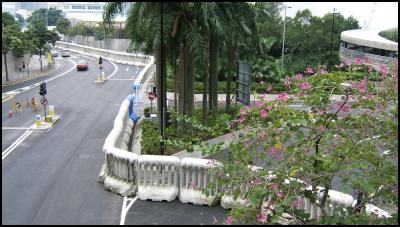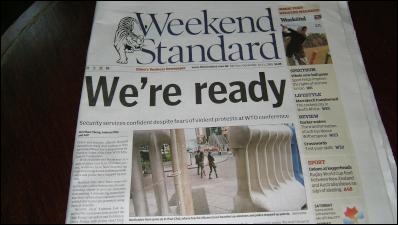Jane Kelsey WTO: Creating a Climate of Fear in HK
Creating a Climate of Fear in Hong Kong
BULLETIN #1 FROM HONG KONG: 10 December 2005
By Dr Jane Kelsey

Click for big version
The scene outside the WTO Meeting Venue in Hong Kong
In four days time, trade ministers from 149 WTO member countries, plus observers from those in the process of accession, will convene in Hong Kong for the 6th ministerial conference of the WTO to discuss the crippled Doha round of trade negotiations.
The Hong Kong government is mustering all its propaganda skills to create a climate of fear as the meeting approaches, to justify cracking down on any dissent and keep the substantive issues off the front pages. The blazing headline from Saturday’s (10-11 December) Weekend Standard simply reads: ‘ We’re ready’, with the subtitle ‘Security services confident despite fears of violent protests at WTO conference’. Below the picture of massive barriers is the caption: ‘Barricades have gone up in Wan Chai, where fearful citizens have boarded up windows and police stepped up patrols’. By contrast, massive colourful posters drawn by local school children welcome the official delegations.
Current estimates suggest anywhere between 2000 and 10,000 activists will gather to challenge the WTO’s agenda, especially farmers, fishers and workers from the Asian region. Three main marches on 11, 13 and 18 December have been organized by the Hong Kong People’s Alliance (HKPA) of local trade unions, migrant workers organisations, churches, research think tanks and other activists. Their commitment is to ensure a strong, non-violent protest.
In addition, a multiplicity of social movements, NGOs and trade unions from outside Hong Kong have arranged a congested programme of briefings, education workshops, speak-outs, people’s tribunals, cultural events and much more.
The collective goal is to send a message to the trade ministers inside the Hong Kong Convention Centre that the WTO’s strategy for global development is incompatible with human rights, social justice, genuine poverty reduction and the right of people and countries to self-determination.
Despite a year-long campaign by the HKPA to educate the media and their fellow citizens, the Hong Kong government is clearly winning the propaganda battle. In the eyes of most locals, opposition to the WTO is purely a ‘law and order’ issue. The first question they ask foreign activists is ‘why are you here to create violence?’
Their question is understandable. In the underground stations and on the buses, locals are warned to leave for work half an hour early in case of disruptions. The venue itself is surrounded by huge water-filled plastic barriers. The small designated ‘protest area’ some distance to the side of the Convention Centre is closed off by a 3 metre high fence with barbed wire. Advertisements, allegedly sponsored by the Thai and Indonesian governments, have advised the thousands of foreign domestic workers that joining the protests could put their jobs at risk. Hotels accommodating the activists and local businesses have been warned to guard against damage to their premises.

Click for big version
For the past year, Hong Kong’s media have been obsessed with stories of violence, fed largely from ‘unidentified’ (government) sources. These are fuelled by distorted and wildly exaggerated images of ‘violent protest’ at previous WTO ministerials. Those who were at Cancun know that, aside from the suicide of Korean farmer Lee Kyung Hae, no one was injured. The only property damage was the symbolic dismantling of the fence that was erected to keep the people 9 kilometres from the Convention centre where the decisions were being made. No protest actions involved any physical violence to anyone - police, delegates, local citizens or holiday makers.
Locals have been constantly reminded that the police have stocked up on ‘non-lethal ammunition’ such as riot shields and rubber bullets, prisons are being emptied and paving stones are being secured so they can’t be used as missiles – reminiscent of Auckland police sealing all the manholes so no terrorist/protestors could pop up at unexpected moments during the APEC meeting in 1999!
Indeed, protest and terrorism are deliberately and mischievously blended. In mid-September the local and foreign press reported that the government had ordered hospitals to stock up on antidotes to cyanide and insecticide in preparation for chemical attacks, as part of its contingency plans for the week of the meeting.
The fear mongering centres on the expected presence of several thousand Koreans. The standard scene-setter from officials has been: ‘What if some Korean peasants suddenly kill themselves amid the protest at the tunnel?’
Last week the government declined to confirm reports that it had a blacklist of 300 activists whom it would deny entry, mostly from Korea. Some 40 countries require visas to enter Hong Kong. In Sri Lanka, the Chinese embassy told students they were not processing applications for NGOs during the ministerial; this was later ‘corrected’. Instead of refusing visas outright, the uncommonly slow processing of applications will keep activists from Vietnam, Pakistan, Nepal, Sri Lanka and Iraq away. Even people who previously worked in Hong Kong or are regular visitors have faced these delays.
People who can enter visa free are being stopped at the border. On Thursday 8th, three women leaders from the Philippines, belonging to the Bayan political party, the Gabriela women’s organisation and the KMU trade union movement, were detained at immigration and taken away for questioning for four hours. Today, the same thing happened to the head of the Philippine peasants movement, the KMP.
Previously, their hotel had written asking for details of the 50 Filipinos staying there and advising that plainclothes police would be visiting the hotel each day to monitor the movements of their ‘guests’. Filipinos are second behind the Koreans on the Hong Kong government’s hit list, as they provide leadership for many of the regional NGOs based in Hong Kong and hold the key to mobilising the huge number of expatriate domestic workers.
The tragedy is that the government of Hong Kong SAR is creating the conditions to convert peaceful and legitimate dissent into confrontation and escalating the risks of conflict. If this happens, it will drown out the message of opposition to the WTO’s agenda from the farmers, fishers, factory workers and migrants whose lives it devastates and the informed analysis of the downsides of the negotiations that the NGOs and trade unions are here to provide.
---- STORY ENDS -----
World Trade: Prelude To WTO Round: Jane Kelsey Reports - The battle for the hearts and minds of Hong Kong took a turn yesterday when the first mass mobilization against the WTO was a colourful, festive and totally peaceful affair. Local media reports expressed surprise; yet their stories were still refracted against the expectation of violence and continued predictions that it will occur. Close to 5000 people rallied in Victoria Park and marched through the streets of Causeway Bay and Wan Chai to government buildings in Central Hong Kong, dancing, singing and chanting “Kong Yee Sai Mau” – Stop the WTO’s Corporate Agenda. See... Jane Kelsey WTO: The Antidote to Fear-Mongering and Jane Kelsey WTO: Creating a Climate of Fear in HK
ALSO: - The battle for the hearts and minds of Hong Kong took a turn yesterday when the first mass mobilization against the WTO was a colourful, festive and totally peaceful affair. Local media reports expressed surprise; yet their stories were still refracted against the expectation of violence and continued predictions that it will occur. Close to 5000 people rallied in Victoria Park and marched through the streets of Causeway Bay and Wan Chai to government buildings in Central Hong Kong, dancing, singing and chanting “Kong Yee Sai Mau” – Stop the WTO’s Corporate Agenda. See... Jane Kelsey WTO: The Antidote to Fear-Mongering and Jane Kelsey WTO: Creating a Climate of Fear in HK
ALSO: | ||


 Binoy Kampmark: Fallibility, Dirty Wars And Pope Francis I
Binoy Kampmark: Fallibility, Dirty Wars And Pope Francis I Peter Dunne: Dunne's Weekly - An Issue No-one Can Afford To Lose
Peter Dunne: Dunne's Weekly - An Issue No-one Can Afford To Lose Martin LeFevre - Meditations: Choosing Mass Murder?
Martin LeFevre - Meditations: Choosing Mass Murder? Eugene Doyle: Quiet Mutiny - The U.S. Army Falls Apart
Eugene Doyle: Quiet Mutiny - The U.S. Army Falls Apart Gordon Campbell: Papal Picks, And India As A Defence Ally
Gordon Campbell: Papal Picks, And India As A Defence Ally Binoy Kampmark: The Selling Of America - Ending The US Dollar’s Exorbitant Privilege
Binoy Kampmark: The Selling Of America - Ending The US Dollar’s Exorbitant Privilege